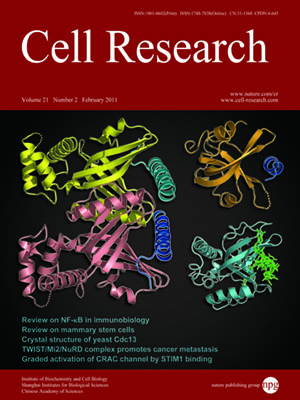
Volume 21, No 2, Feb 2011
ISSN: 1001-0602
EISSN: 1748-7838 2018
impact factor 17.848*
(Clarivate Analytics, 2019)
Volume 21 Issue 2, February 2011: 258-274
ORIGINAL ARTICLES
Structural bases of dimerization of yeast telomere protein Cdc13 and its interaction with the catalytic subunit of DNA polymerase α
Jia Sun1,2, Yuting Yang1,2, Ke Wan1,2, Ninghui Mao3, Tai-Yuan Yu4, Yi-Chien Lin4, Diane C DeZwaan5, Brian C Freeman5, Jing-Jer Lin4, Neal F Lue3 and Ming Lei1,2
1Howard Hughes Medical Institute
2Department of Biological Chemistry, University of Michigan Medical School, 1150 W. Medical Center Drive, Ann Arbor, MI 48109, USA
3Department of Microbiology & Immunology, W.R. Hearst Microbiology Research Center, Weill Medical College of Cornell University, 1300 York Avenue, New York, NY 10065, USA
4Institute of Biopharmaceutical Sciences, National Yang-Ming University, Shih-Pai 112, Taipei
5Department of Cell and Developmental Biology, University of Illinois, 601 South Goodwin Avenue, Urbana, IL 61801, USA
Correspondence: Ming Lei,(leim@umich.edu)
Budding yeast Cdc13-Stn1-Ten1 (CST) complex plays an essential role in telomere protection and maintenance, and has been proposed to be a telomere-specific replication protein A (RPA)-like complex. Previous genetic and structural studies revealed a close resemblance between Stn1-Ten1 and RPA32-RPA14. However, the relationship between Cdc13 and RPA70, the largest subunit of RPA, has remained unclear. Here, we report the crystal structure of the N-terminal OB (oligonucleotide/oligosaccharide binding) fold of Cdc13. Although Cdc13 has an RPA70-like domain organization, the structures of Cdc13 OB folds are significantly different from their counterparts in RPA70, suggesting that they have distinct evolutionary origins. Furthermore, our structural and biochemical analyses revealed unexpected dimerization by the N-terminal OB fold and showed that homodimerization is probably a conserved feature of all Cdc13 proteins. We also uncovered the structural basis of the interaction between the Cdc13 N-terminal OB fold and the catalytic subunit of DNA polymerase a (Pol1), and demonstrated a role for Cdc13 dimerization in Pol1 binding. Analysis of the phenotypes of mutants defective in Cdc13 dimerization and Cdc13-Pol1 interaction revealed multiple mechanisms by which dimerization regulates telomere lengths in vivo. Collectively, our findings provide novel insights into the mechanisms and evolution of Cdc13.
Cell Research (2011) 21: 258-274. doi:10.1038/cr.2010.138; published online 28 September 2010
FULL TEXT | PDF
Browse 2877


